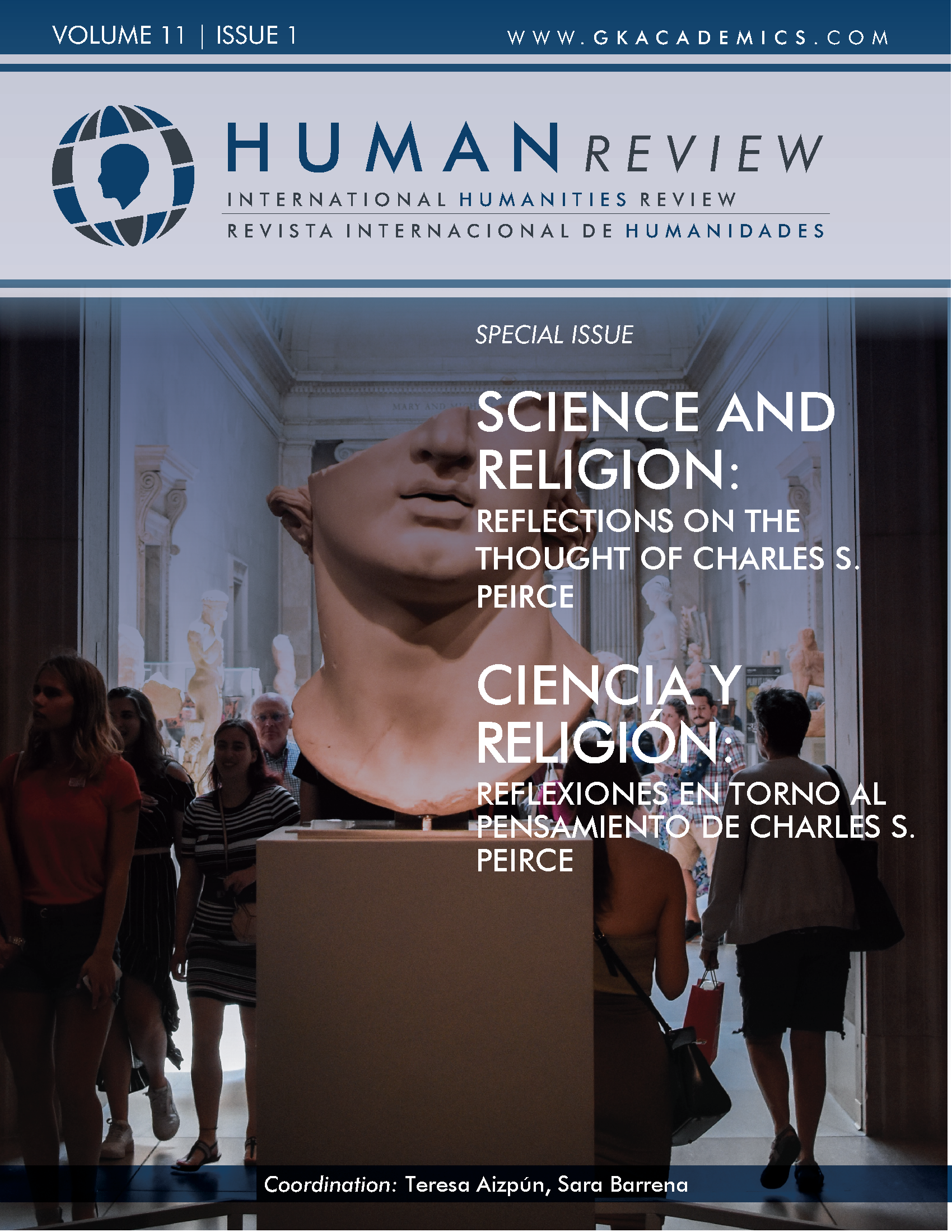Semiótica, computación, mecanicismo y libertad
¿Un argumento semiótico en favor de la existencia de Dios?
DOI:
https://doi.org/10.37467/gkarevhuman.v11.3226Palavras-chave:
Tablilla de cera, Representación de la información, Mecanicismo, Semiótica peirceanaResumo
Una larga tradición, que arranca en la metáfora de la tablilla de cera presentada en el Teeteto de Platón, lleva a pensar que la relación entre la representación mental y la realidad representada es en cierto modo mecánica o automática. Pero lo cierto es que los aspectos convencionales de la significación hacen imposible comprenderla como un proceso físico-mecánico. Las ciencias de la computación, contrariamente a una visión superficial, no apoyan sino desmienten esa concepción mecanicista de la racionalidad, confirmando que la semiosis solo puede darse en sujetos libres, es decir, no completamente sometidos a las leyes de la materia.
Referências
Ayim, M. (1974). Retroduction: The Rational Instinct. Transactions of the Charles S. Peirce Society, 10(1), 34–43. https://www.jstor.org/stable/40319699
Ayim, M. (1982). Peirce’s View of the Roles of Reason and Instinct in Scientific Inquiry. Anu Prakasan.
Balasch, M. (1990). Platón. Teeteto. Anthropos.
Barrena, S. (1996). Charles S. Peirce: Un argumento olvidado en favor de la realidad de Dios. Introducción, traducción y notas. Cuadernos de Anuario Filosófico, Serie Universitaria Nº 34. Servicio de Publicaciones de la Universidad de Navarra.
Churchland, P. (2016, September 1). Will brain science change criminal law? 20 Big Questions about the Future of Humanity. Scientific American. https://www.scientificamerican.com/article/20-big-questions-about-the-future-of-humanity/
Crespo, M. (1998). ¿Son las leyes lógicas leyes psicológicas? Aporías de la interpretación psicologista de la lógica. Twentieth World Congress of Philosophy. https://www.bu.edu/wcp/Papers/TKno/TKnoCres.htm DOI: https://doi.org/10.5840/wcp20-paideia199845865
Dennett, D. (1991). Consciousness Explained. The Penguin Press.
Fodor, J. (1975). The Language of Thought. Harvard University Press.
García Norro, J.J. (2012). ¿Es natural la inteligencia? En: M. Oriol (Ed.), Inteligencia y filosofía (pp. 151-169). Marova.
Gelernter, D. (2016). The Tides of Mind: Uncovering the Spectrum of Consciousness. Liveright.
Génova, G. (1997). Charles S. Peirce: La lógica del descubrimiento [Tesis de Licenciatura en Filosofía]. Cuadernos de Anuario Filosófico, Serie Universitaria Nº 45. Servicio de Publicaciones de la Universidad de Navarra.
Génova, G., & Quintanilla Navarro, I. (2018a). Are Human Beings Humean Robots? Journal of Experimental Theoretical Artificial Intelligence, 30(1), 177–186. https://doi.org/10.1080/0952813X.2017.1409279 DOI: https://doi.org/10.1080/0952813X.2017.1409279
Génova, G., & Quintanilla Navarro, I. (2018b). Discovering the principle of finality in computational machines. Foundations of Science, 23(4), 779–794. https://doi.org/10.1007/s10699-018-9552-4 DOI: https://doi.org/10.1007/s10699-018-9552-4
Génova, G., Moreno, V., & González, M.R. (2022). A Lesson from AI: Ethics Is Not an Imitation Game. IEEE Technology and Society Magazine, 41(1), 75–81. https://doi.org/10.1109/MTS.2022.3147531 DOI: https://doi.org/10.1109/MTS.2022.3147531
Génova, G., Moreno, V., & Parra, E. (2022). A free mind cannot be digitally transferred. AI & Society [En revisión]. DOI: https://doi.org/10.1007/s00146-022-01519-7
Génova, G., Valiente, M.C., & Nubiola, J. (2005). A Semiotic Approach to UML Models. First International Workshop on Philosophical Foundations of Information Systems Engineering (PHISE 2005). Porto, Portugal. Held in conjunction with the 17th Conference on Advanced Information Systems Engineering (CAiSE 2005). Proceedings of the CAiSE’05 Workshops, 2, 547–557.
Génova, G., Valiente, M.C., & Nubiola, J. (2006). Modelos en UML: un enfoque semiótico. Novática, 180, 57– 62.
Gonzalez, F. (2007). Wax Tablets, Aviaries, or Imaginary Pregnancies? On the Powers in Theaetetus’ Soul. Études platoniciennes, 4, 273–293. https://doi.org/10.4000/etudesplatoniciennes.917 DOI: https://doi.org/10.4000/etudesplatoniciennes.917
González Quirós, J.L. (2021). Sally Brown y los filósofos griegos: ¿tenemos todavía algo que aprender de ellos? HUMAN REVIEW. International Humanities Review / Revista Internacional De Humanidades, 10. https://doi.org/10.37467/gkarevhuman.v10.3079 DOI: https://doi.org/10.37467/gkarevhuman.v10.3079
Hofstadter, D.R. (1987). Gödel, Escher, Bach: un Eterno y Grácil Bucle. Tusquets Editores.
Lewis, C.S. (1947). Miracles: A Preliminary Study. Collins/Fontana.
Nagel, T. (2012). Mind and Cosmos: Why the Materialist Neo-Darwinian Conception of Nature Is Almost Certainly False. Oxford University Press. DOI: https://doi.org/10.1093/acprof:oso/9780199919758.001.0001
Nubiola, J. (2012). John Henry Newman y Charles S. Peirce: conexiones y afinidades. V Jornadas Peirce en Argentina. Academia Nacional de Ciencias, Buenos Aires. https://www.unav.es/gep/JornadasPeirceArgentina.html
Peirce, C.S. (1893). Evolutionary Love (CP 6.287–317). In C. Hartshorne, P. Weiss & A. W. Burks (Eds.), The Collected Papers of Charles Sanders Peirce, vols. 1-8 (S. Barrena, Trad.). Harvard University Press. https://www.unav.es/gep/AmorEvolutivo.html
Peirce, C.S. (1897). Ground, Object and Interpretant (CP 2.228). In C. Hartshorne, P. Weiss & A. W. Burks (Eds.), The Collected Papers of Charles Sanders Peirce, vols. 1-8. Harvard University Press.
Peirce, C.S. (1903). A Second Trichothomy of Signs (CP 2.247–249). In C. Hartshorne, P. Weiss y A. W. Burks (Eds.), The Collected Papers of Charles Sanders Peirce, vols. 1-8. Harvard University Press.
Peirce, C.S. (c.1902). Why Study Logic? (CP 2.135–139). In C. Hartshorne, P. Weiss & A. W. Burks (Eds.), The Collected Papers of Charles Sanders Peirce, vols. 1-8. Harvard University Press.
Plantinga, A. (1993). Warrant and Proper Function. Oxford University Press. DOI: https://doi.org/10.1093/0195078640.001.0001
Putnam, H. (1988). Mind, Language and Reality. Cambridge University Press.
Reppert, V. (1999). The Argument from Reason. PhiLo, 2(1), 33–45. https://www.lewissociety.org/reason/, https://doi.org/10.5840/philo1999214 DOI: https://doi.org/10.5840/philo1999214
Reppert, V. (2003). C.S. Lewis's Dangerous Idea: In Defense of the Argument from Reason. InterVarsity Press.
Tallis, R. (2004). Why the Mind Is Not a Computer: A Pocket Lexicon of Neuromythology. Imprint Academic.
Downloads
Publicado
Como Citar
Edição
Seção
Licença
Os autores/as que publicam nesta revista concordam com os seguintes termos:
- Os autores/as terão os direitos morais do trabalho e cederão para a revista os direitos comerciais.
- Um ano após a sua publicação, a versão do editor estará em acesso aberto no site da editora, mas a revista manterá o copyright da obra.
- No caso dos autores desejarem asignar uma licença aberta Creative Commons (CC), poderão a solicitar escrevendo a publishing@eagora.org.









